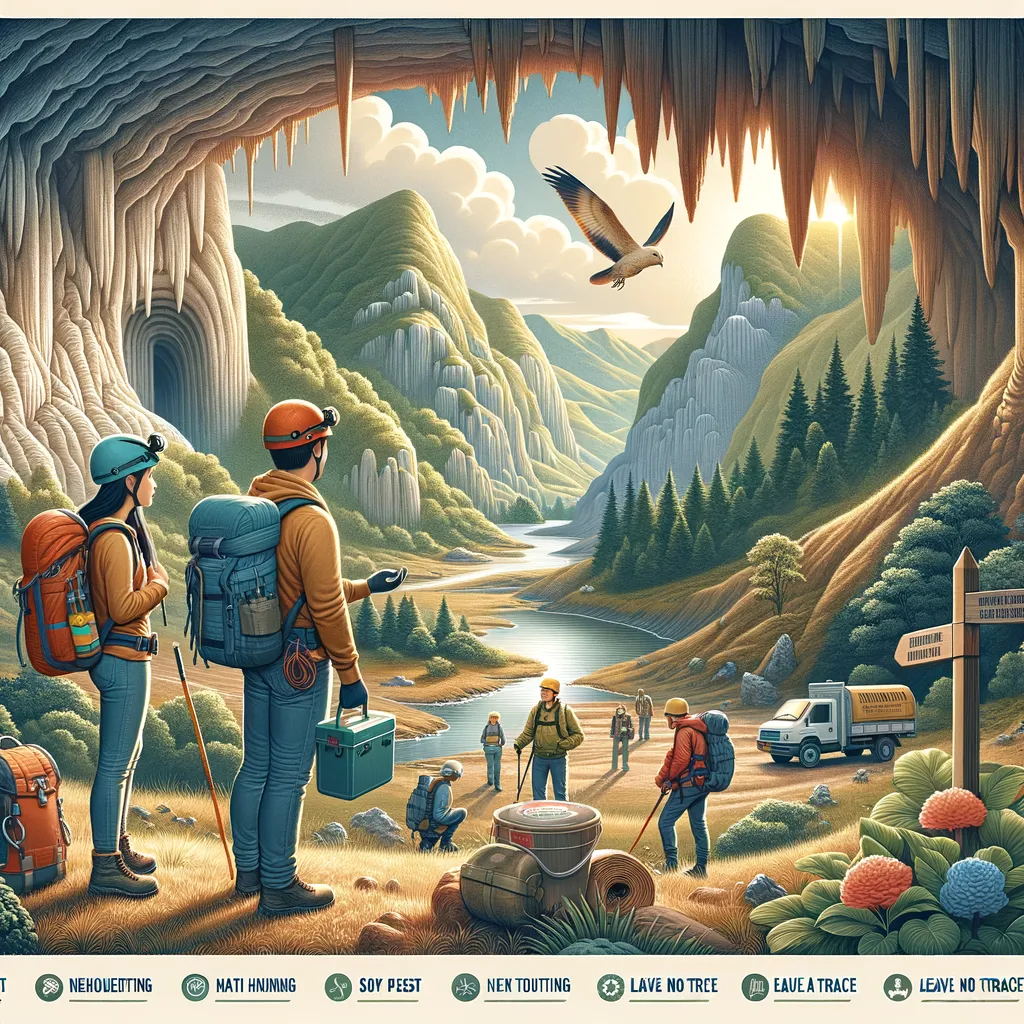Discover the Thrills of Cave Exploration: A Family Guide to Safe and Fun Adventures
Welcome to the ultimate parent’s guide to safely exploring caves and tunnels with your family! Bursting with excitement and holding the promise of adventure, the world beneath our feet offers a unique way to bond with your family, teach valuable lessons about nature, and create unforgettable memories. But as with any adventure, safety comes first. In this comprehensive guide, we’ll walk you through the essential tips and tricks to ensure your underground excursions are not only thrilling but also absolutely safe.
Why Explore Caves with Your Family?
Caving, also known as spelunking, is an exhilarating experience that can help kids and adults alike develop a sense of curiosity, respect for nature, and a strong bond with each other. It’s an opportunity to learn about geology, biology, and ecology in a hands-on environment. Plus, overcoming challenges together in a cave can boost confidence and teamwork in a family. So, let’s delve into the world beneath and discover the joys of cave exploration together!
Understanding the Basics of Cave Safety
Before you lace up your boots and grab your flashlight, it’s crucial to understand the basics of cave safety. Caves can be unpredictable environments, and being prepared is your first step toward a safe and enjoyable adventure. Here, we’ll cover the foundational knowledge every family should have before setting out to explore the underground.
1. Start with Research and Preparation
Every cave has its own story, with unique features, challenges, and requirements. Start your adventure with thorough research. Look for beginner-friendly caves that are known for their safe passages and have guided tours available. Understanding the cave’s layout, difficulty level, and any potential hazards (like sudden drops or water sections) is vital. Also, always check the weather conditions, as heavy rains can quickly flood caves, creating dangerous situations.
2. Gear Up Properly
Equipping yourselves with the right gear is an essential part of cave safety. At a minimum, each member of your family should have:
- A sturdy helmet to protect against bumps and falling rocks.
- A reliable, waterproof headlamp or flashlight, plus extra batteries. Natural light fades away just a few steps into a cave, so good lighting is crucial.
- Gloves to protect your hands from sharp rocks and to improve your grip.
- Durable, water-resistant clothing and footwear. Caves can be wet and muddy, so staying dry helps in maintaining comfort and reducing hypothermia risk.
3. Join a Guided Tour or Cave Exploration Group
If you’re new to caving, joining a guided tour or a local caving club is a fantastic way to gain experience. Guides and experienced cavers can provide invaluable insights about navigating caves safely, spotting interesting features, and minimizing your ecological impact. Plus, exploring with a group adds an extra layer of safety.
4. Respect the Cave’s Environment
Caves are fragile ecosystems, home to unique species and geological formations that have taken thousands of years to form. Teach your family the importance of preserving these natural wonders:
- Avoid touching delicate formations. Oils from human skin can stop their growth or even damage them.
- Stay on marked paths to reduce your impact on the cave environment.
- Carry out all trash, and don’t leave anything behind. Remember, caves are not just adventurous playgrounds but also precious natural habitats.
As you prepare to embark on your caving adventure, remember that the key to a successful exploration lies in preparation, respect for nature, and ensuring the safety of all participants. By following these guidelines, you and your family are set to discover the wonders of the underground world in a safe, responsible, and fun way.
Stay tuned for more detailed information on how to enhance your caving experience with tips on advanced preparations, educational opportunities, and ways to turn your family’s cave adventure into a thrilling educational journey that will be remembered for years to come.

5 Essential Tips for Parents: Preparing for Safe Cave and Tunnel Exploration
Cave and tunnel exploration can be a wonderful adventure for families, offering both children and adults alike the chance to learn about the natural world from an entirely new perspective. While the allure of hidden passageways and ancient formations can be irresistible, it’s crucial for parents to plan these expeditions with utmost care and consideration for safety. Here are five key things parents should know to ensure their family’s cave exploration adventure is not only exhilarating but also safe.
1. Understanding Cave Types and Risks
Not all caves are created equal. From the vast, echoing chambers of show caves that are often equipped with pathways and lighting, to the untouched beauty of wild caves that remain in their natural state, the variety is endless. It’s essential for parents to understand the type of cave they plan to explore and the risks associated with each. Show caves, for instance, offer a safer environment for young children and first-time cavers. In contrast, wild caves require more preparation and offer a more challenging experience. Knowing what to expect can help you prepare adequately for the adventure ahead.
2. Educating the Family About Cave Conservation
Caving is not just about exploration; it’s also about conservation. Teaching your family the importance of cave conservation is a vital step in preparing for your journey. Discuss why it’s important to not touch formations, as human contact can harm delicate ecosystems within the cave. Highlight the significance of not littering and the need to stay on designated paths to preserve the cave’s natural beauty for future generations. Instilling a sense of responsibility and stewardship helps ensure the continued splendor of these underground wonders.
3. Physical Preparation and Fitness
Caving can be physically demanding. Navigating uneven terrain, squeezing through narrow passages, and sometimes climbing or crawling requires a good level of physical fitness. Depending on the complexity of the cave, it might be wise to engage in preparatory activities that build stamina and strength. Simple activities, such as hiking, swimming, or even regular walks can be beneficial in preparing everyone for the physical demands of caving. It’s also crucial to assess each family member’s fitness and readiness to ensure the adventure remains enjoyable and safe for everyone.
4. Packing the Right Equipment
A successful caving adventure hinges on having the right equipment. Beyond the basics of helmets, headlamps, and protective clothing, consider the specific needs of your chosen cave. For instance, if water passages are involved, waterproof gear or even a change of clothes might be necessary. Similarly, for longer expeditions, snacks, water, and a basic first aid kit should be included in your pack. Tailor your equipment list to the cave’s requirements and the length of your exploration, ensuring you’re prepared for any scenario.
5. Emotional Preparation and Setting Expectations
Finally, preparing your family emotionally and setting realistic expectations is as important as any physical preparation. Discuss what to expect during the exploration, including potential challenges and how to address them. It’s important for everyone to know that it’s okay to feel anxious and that they can express their feelings openly. Setting clear expectations helps manage any worries and contributes to a positive experience. Emphasize teamwork, support, and the shared goal of enjoying and learning from the adventure.
Embarking on a cave and tunnel exploration with your family can be a rewarding experience, filled with learning opportunities and the thrill of discovery. By understanding the types of caves and associated risks, educating your family about conservation, ensuring physical readiness, packing appropriately, and preparing emotionally, you can set the stage for a safe and memorable journey. Remember, the key to a successful exploration lies in thorough preparation, respect for nature, and ensuring the safety of all participants. With these guidelines in mind, you and your family are well on your way to uncovering the mysteries that lie beneath the surface.
Disclaimer
The articles available via our website provide general information only and we strongly urge readers to exercise caution and conduct their own thorough research and fact-checking. The information presented should not be taken as absolute truth, and, to the maximum extent permitted by law, we will not be held liable for any inaccuracies or errors in the content. It is essential for individuals to independently verify and validate the information before making any decisions or taking any actions based on the articles.



